PRE2017 1 Groep1: Difference between revisions
| Line 16: | Line 16: | ||
Today, there are several different psychological theories on crowds. There is Gustave Le Bon's theory, Sigmund Freud's theory, Ralph Turner’s theory, Henri’s Tajfel’s theory and many more.. Each of these theories have a different perspective on the psychology of a crowd and its members. It is important to look at these theories when designing a crowd management solution. The psychology of a crowd tells about the interaction between individuals, thoughts of the masses and tells about the (unpredictable) actions of these crowds. Knowing the inner processes in a crowd explains the origin of all kinds of problems within a crowd, such as uproar, violence, mass rallying, panic and so on. | Today, there are several different psychological theories on crowds. There is Gustave Le Bon's theory, Sigmund Freud's theory, Ralph Turner’s theory, Henri’s Tajfel’s theory and many more.. Each of these theories have a different perspective on the psychology of a crowd and its members. It is important to look at these theories when designing a crowd management solution. The psychology of a crowd tells about the interaction between individuals, thoughts of the masses and tells about the (unpredictable) actions of these crowds. Knowing the inner processes in a crowd explains the origin of all kinds of problems within a crowd, such as uproar, violence, mass rallying, panic and so on. | ||
Therefore theories mentioned earlier will be looked into, as to investigate why or where a robot can best help interacting and managing a crowd. | Therefore theories mentioned earlier will be looked into, as to investigate why or where a robot can best help interacting and managing a crowd. | ||
==== Irrational theory | ==== Irrational theory ==== | ||
First off, Gustave Le Bon's Theory is looked into. Gustave Le Bon wrote ‘Mind of the Crowd’ and with that started the psychology of masses department in psychology, which now-a-days branches to politics, conventional and social media and many other. In this ‘Mind of the Crowd’, Le Bon argues that individuals are no longer themselves. Would an individual been alone, he would kept himself under restraint. Le Bon says ‘he is no longer conscious of his acts’. His argument is that a crowd is irrational. It does not think for itself, it only acts. An important quote from his work: | First off, Gustave Le Bon's Theory is looked into. Gustave Le Bon wrote ‘Mind of the Crowd’ and with that started the psychology of masses department in psychology, which now-a-days branches to politics, conventional and social media and many other. In this ‘Mind of the Crowd’, Le Bon argues that individuals are no longer themselves. Would an individual been alone, he would kept himself under restraint. Le Bon says ‘he is no longer conscious of his acts’. His argument is that a crowd is irrational. It does not think for itself, it only acts. An important quote from his work: | ||
We see, then, that the disappearance of the conscious | We see, then, that the disappearance of the conscious | ||
| Line 33: | Line 33: | ||
Secondly, Sigmund Freud’s theory. Sigmund Freud is a well-respected psychologist published ‘Group Psychology and the Analysis of the Ego’ in 1921. In fact, this is the base for his most famous published work ‘The Ego and the Id’. In his ‘Group Psychology and the Analysis of the Ego’, Freud also argues that the individuals in large groups form an irrational crowd acting on suggested ideas. However, the reasoning is different. Freud suggests that the so called ‘super-ego’, the part of the ego that is conscious and responsible for our inner reasoning is overthrown in a group. The intensification of emotion in a group by contagion is not accounted for by the super-ego. Freud argues that through a crowd, the super-ego’s restraints on a person’s behavior is minimalized and these restraints are replaced by impulses from, for example a charismatic crowd leader creating simple emotions instead of complex ones, as simple ones are easier to interpret for the restraint super-ego. This is for example how dictators like Hitler manipulated crowds he believes. The difference here between Le Bon and Freud is that people not merely stop thinking, but are overwhelmed in contagious emotion. Though the conclusion is similar, the individual starts being an actor incapable of reason instead of a rational being. | Secondly, Sigmund Freud’s theory. Sigmund Freud is a well-respected psychologist published ‘Group Psychology and the Analysis of the Ego’ in 1921. In fact, this is the base for his most famous published work ‘The Ego and the Id’. In his ‘Group Psychology and the Analysis of the Ego’, Freud also argues that the individuals in large groups form an irrational crowd acting on suggested ideas. However, the reasoning is different. Freud suggests that the so called ‘super-ego’, the part of the ego that is conscious and responsible for our inner reasoning is overthrown in a group. The intensification of emotion in a group by contagion is not accounted for by the super-ego. Freud argues that through a crowd, the super-ego’s restraints on a person’s behavior is minimalized and these restraints are replaced by impulses from, for example a charismatic crowd leader creating simple emotions instead of complex ones, as simple ones are easier to interpret for the restraint super-ego. This is for example how dictators like Hitler manipulated crowds he believes. The difference here between Le Bon and Freud is that people not merely stop thinking, but are overwhelmed in contagious emotion. Though the conclusion is similar, the individual starts being an actor incapable of reason instead of a rational being. | ||
Because the conclusion of this theory is the same, the same principles can be applied for using a robot riot support unit. One note on that however, Freud suggests that charismatic leaders have an extra effect on the actions of a crowd. Identifying and recognizing these individuals would be an almost impossible task for robots. However what support they could provide is whenever such a person is identified by law enforcement, robots can provide a way to penetrate the crowd and lead in law enforcement to enable arrest. | Because the conclusion of this theory is the same, the same principles can be applied for using a robot riot support unit. One note on that however, Freud suggests that charismatic leaders have an extra effect on the actions of a crowd. Identifying and recognizing these individuals would be an almost impossible task for robots. However what support they could provide is whenever such a person is identified by law enforcement, robots can provide a way to penetrate the crowd and lead in law enforcement to enable arrest. | ||
=== Emergent norm theory === | |||
==== Emergent norm theory ==== | |||
Although Le Bon and Freud argue for an irrational crowd, Ralph Turner argues for a largely rational crowd. He published his ‘emergent norm theory’ just after Freud’s theory. He argues that people initially, in all types and sizes of crowds, do not know how to behave. Because social interaction, people start behaving like the norms of people around them. Important is that this, in contrary to the other theories, makes this crowd theory dependent on situational factors. Essentially Ralph Turner argues that social order and rationality guide behavior. This means that still, charismatic leaders will create norms that guide crowds, however these norms might not be acceptable for the individual in the crowd. The norms formed by the individual can be explained by anonymity, stimulation, emotion, contagion, legality and much more. | Although Le Bon and Freud argue for an irrational crowd, Ralph Turner argues for a largely rational crowd. He published his ‘emergent norm theory’ just after Freud’s theory. He argues that people initially, in all types and sizes of crowds, do not know how to behave. Because social interaction, people start behaving like the norms of people around them. Important is that this, in contrary to the other theories, makes this crowd theory dependent on situational factors. Essentially Ralph Turner argues that social order and rationality guide behavior. This means that still, charismatic leaders will create norms that guide crowds, however these norms might not be acceptable for the individual in the crowd. The norms formed by the individual can be explained by anonymity, stimulation, emotion, contagion, legality and much more. | ||
Modern individual theories like Henri Tajfel’s social identity theory argue that individuals are not guided by the crowd, but by norms set by their social identity. This means that individuals are dictated in their morals and norms by groups to whom they are primarily are related to. These can be religious, cultural, politically or any other form of group that sets morals and norms. This way crowds are more versatile than in other theories. This theory argues that because of these crowds formed by social identity, people feel united, have a high self-esteem and have pride for this group. This causes prejudiced views of other groups or non-members, and depending on the groups moral/norms, can cause violence or other problems. This theory argues that also, crowds are largely irrational, since the prevailing cause of action is the norms set by a group. | Modern individual theories like Henri Tajfel’s social identity theory argue that individuals are not guided by the crowd, but by norms set by their social identity. This means that individuals are dictated in their morals and norms by groups to whom they are primarily are related to. These can be religious, cultural, politically or any other form of group that sets morals and norms. This way crowds are more versatile than in other theories. This theory argues that because of these crowds formed by social identity, people feel united, have a high self-esteem and have pride for this group. This causes prejudiced views of other groups or non-members, and depending on the groups moral/norms, can cause violence or other problems. This theory argues that also, crowds are largely irrational, since the prevailing cause of action is the norms set by a group. | ||
Revision as of 21:32, 1 October 2017
| Members of group 1 | |
| Bern Klein Holkenborg, Mechanical Engineer | |
| Sjoerd van Heesbeen, Mathematician | |
| Luke van Unen, Software Scientist | |
Introduction
In this project, problems are solved from a societal perspective. Engineers usually look at engineering problems, but fail to notice that either the problem is of no issue for the user or society, or the problem may be irrelevant for the problem the user or society has. This project explores the utility of just that: looking from a user's need. For the course a problem is posed which is be detailed below.
Problem Definition
Crowd Theory
Today, there are several different psychological theories on crowds. There is Gustave Le Bon's theory, Sigmund Freud's theory, Ralph Turner’s theory, Henri’s Tajfel’s theory and many more.. Each of these theories have a different perspective on the psychology of a crowd and its members. It is important to look at these theories when designing a crowd management solution. The psychology of a crowd tells about the interaction between individuals, thoughts of the masses and tells about the (unpredictable) actions of these crowds. Knowing the inner processes in a crowd explains the origin of all kinds of problems within a crowd, such as uproar, violence, mass rallying, panic and so on. Therefore theories mentioned earlier will be looked into, as to investigate why or where a robot can best help interacting and managing a crowd.
Irrational theory
First off, Gustave Le Bon's Theory is looked into. Gustave Le Bon wrote ‘Mind of the Crowd’ and with that started the psychology of masses department in psychology, which now-a-days branches to politics, conventional and social media and many other. In this ‘Mind of the Crowd’, Le Bon argues that individuals are no longer themselves. Would an individual been alone, he would kept himself under restraint. Le Bon says ‘he is no longer conscious of his acts’. His argument is that a crowd is irrational. It does not think for itself, it only acts. An important quote from his work: We see, then, that the disappearance of the conscious personality, the predominance of the unconscious personality, the turning by means of suggestion and contagion of feelings and ideas in an identical direction, the tendency to immediately transform the suggested ideas into acts; these, we see, are the principal characteristics of the individual forming part of a crowd. He is no longer himself, but has become an automaton who has ceased to be guided by his will.
In other words, rationality translates to irrationality by contagion of feeling and ideas in identical direction. And irrationality leads to immediate acting upon ideas, thus the individual started being an actor incapable of reason instead of a rational being.
Although in the 1960’s the theory of irrational crowds was widely rejected, now-a-days this theory is taken in consideration again in some behalf. Take the Burnley Riots in England 2001. Young people were discontent about their living conditions. There was unemployment, poverty, crime and other conditions. In 2001, these youngsters started looting shopping centers and setting cars alight. Initially, law enforcement tried to communicate with the rioters, however soon noticed the riot and its members were irrational, and in no way able to negotiate. Homes were petrol bombed, families were attacked, and ofcourse law enforcement got attacked. Petrol bombs, stones and other projectiles were hurled at the police. People joined the riots just for the sake of looting or for violence. The riot eventually caused over 300 officers to be hurt. So how could robots have helped the law enforcement? A mobile barrier between rioters and law enforcement could have probably prevented many officer injuries, and could have created safe areas in critical zones. Robots could have literally provided this mobile barrier and even more. Robots could have acted as riot control unit equipped with water guns and/or cameras.
Secondly, Sigmund Freud’s theory. Sigmund Freud is a well-respected psychologist published ‘Group Psychology and the Analysis of the Ego’ in 1921. In fact, this is the base for his most famous published work ‘The Ego and the Id’. In his ‘Group Psychology and the Analysis of the Ego’, Freud also argues that the individuals in large groups form an irrational crowd acting on suggested ideas. However, the reasoning is different. Freud suggests that the so called ‘super-ego’, the part of the ego that is conscious and responsible for our inner reasoning is overthrown in a group. The intensification of emotion in a group by contagion is not accounted for by the super-ego. Freud argues that through a crowd, the super-ego’s restraints on a person’s behavior is minimalized and these restraints are replaced by impulses from, for example a charismatic crowd leader creating simple emotions instead of complex ones, as simple ones are easier to interpret for the restraint super-ego. This is for example how dictators like Hitler manipulated crowds he believes. The difference here between Le Bon and Freud is that people not merely stop thinking, but are overwhelmed in contagious emotion. Though the conclusion is similar, the individual starts being an actor incapable of reason instead of a rational being. Because the conclusion of this theory is the same, the same principles can be applied for using a robot riot support unit. One note on that however, Freud suggests that charismatic leaders have an extra effect on the actions of a crowd. Identifying and recognizing these individuals would be an almost impossible task for robots. However what support they could provide is whenever such a person is identified by law enforcement, robots can provide a way to penetrate the crowd and lead in law enforcement to enable arrest.
Emergent norm theory
Although Le Bon and Freud argue for an irrational crowd, Ralph Turner argues for a largely rational crowd. He published his ‘emergent norm theory’ just after Freud’s theory. He argues that people initially, in all types and sizes of crowds, do not know how to behave. Because social interaction, people start behaving like the norms of people around them. Important is that this, in contrary to the other theories, makes this crowd theory dependent on situational factors. Essentially Ralph Turner argues that social order and rationality guide behavior. This means that still, charismatic leaders will create norms that guide crowds, however these norms might not be acceptable for the individual in the crowd. The norms formed by the individual can be explained by anonymity, stimulation, emotion, contagion, legality and much more. Modern individual theories like Henri Tajfel’s social identity theory argue that individuals are not guided by the crowd, but by norms set by their social identity. This means that individuals are dictated in their morals and norms by groups to whom they are primarily are related to. These can be religious, cultural, politically or any other form of group that sets morals and norms. This way crowds are more versatile than in other theories. This theory argues that because of these crowds formed by social identity, people feel united, have a high self-esteem and have pride for this group. This causes prejudiced views of other groups or non-members, and depending on the groups moral/norms, can cause violence or other problems. This theory argues that also, crowds are largely irrational, since the prevailing cause of action is the norms set by a group. To illustrate these two theories, take the Baltimore 2015 riots. The Baltimore 2015 riots came about when Baltimore Police arrested Freddie Gray. Gray died from injuries to his neck and back, caused by his arrest by 6 officers. His arrest caused uproar in the black Baltimore society. Why this riot is interesting is because the stages of escalation. First peaceful protests were held against police violence. Peaceful norms were abided. However, more people joined the protests, and naturally the occasional arrests were made. Some protesters started harassing police offers, and later many followed. A new norm was set by the crowd, in which emotion, contagion and anonymity played part. The protests intensified because of the fact that Freddie Gray was black, which many protesters identified with. Finally a full scale riot happened with over 200 fire incidents to houses and vehicles. Also many looting occurred. In the end, thousands of officers were deployed to contain the riots, and resulted in many police injuries. Again, a mobile barrier and additional information could have prevented looting, fires and injuries from happening. It wouldn’t have prevented the riot from happening, but it would have contained the damage it has done.
Concluding from these theories and the robot implications of these theories, is that robots would not stop riots from happening. This however does not say robots have no use in riots. Robots can definitely impact riots positively, they could possibly lower the chance of escalation, but definitely lower the chance of damage and injury. A robot that could act as barrier, riot control unit or information system can definitely prevent harm to police, and thus also to rioters and non-partaking individuals.
Objective
As described above, to keep up with population growth, the police force has to evolve to a (partly) automated force. The objective for the project is just that. A robot should be created to automate an otherwise employee intensive police task. Without bringing user or society at risk. The robot should be safe to interact with, useful and be able to cope with every situation it faces. There are already "real" police robots providing assistance to citizens (Dubai). However they are often seen as lacking in most capabiltiies compared to human officers. The scope of the project would be far to great to design such a complete officer replacement robot. Instead in this project we will try tackling a specific police task. Some examples of such a tasks would be: Speeding control, a mobile robot could check wherever, whenever for speeding cars. Or an automated alchohol check, a robot could be set up to automatically check if a driver is allowed to drive or not. Or a robot that monitors a vehicle chase, a mobile robot unit might be faster, cheaper and more varsetile than a police helicopter.
Approach
To tackle a good problem, we would like to investigate how and why a police task is performed and how this could be improved upon by utilizing robots. We would like to be in contact with dutch police staff to define these tasks, and also narrow it down to a single well defined problem. The task should be investigated in detail by means of real world examples. As before, why and how it is done in its current way, what rules there are, what is vital to keep in mind for a good result, how people respond to the actions being taken, and if all this permits for robots to enhance the tasks being performed. When all these parameters are well defined, a robot can be designed both technically and functionally. After designing the robot, the design has to be verified by both the police and users which can be done by enquete, interview and maybe even a prototype test.
Deliverable
Our deliverable consists out of two things, first there is the concept design created by us, second there will be a case study where a recent case is analyzed and the effect of our design on that particular case elaborated. Our concept design will be focused on the physical abilities of the robot, it will consist out of a standard model and some modules that can be attached to the robot, in case of special needs. Of this standard model there will be a clear design, this holds a drawing of the robot with all applications and materials specified. To design this kind of robot we need some requirements, preferences and constraints which the robot must have. The police will have some ideas too about these requirements, so we will use them as feedback or evaluation. These RPC’s have to do with the different abilities the robot must have to clear the streets. There are RPC’s for the following abilities: Movement, obstacle recognition, modules, communication
- Movement:
- Able to move in every direction
As the robot comes across different obstacles, but must remain in formation, it must be able to move in every direction.
- Able to climb small obstacles like sidewalks
When holding formation, the robot can come across obstacles that are not that high, so they must be able to climb over it to hold the formation. Preferred is being able to climb obstacles of at least twenty centimeters
- Object recognition:
- Able to detect common street-obstacles, like streetlights, trashcans and poles
When going through a street there are a lot of obstacles, the robot can’t go through them, so it has to detect and eventually avoid them
- Able to distinguish rioters and police
- Modules:
We distinguish two modules: a shield and a water gun.
- Shield:
o Connection point for the shield
o Robot must be able to push, this is done by a strong engine and a movement mechanism with strong grip.
Preferred is being able to push at least five people, this is an estimate of the number that are able to push on one single robot
- Water gun:
o Connection point for the water hose and the water gun
o Strong grip, enough to hold the recoil
- Communication:
- Able to speak to the crowd as warning
By warning the crowd, they get the chance to walk away without being charged by the robots
- Able to receive orders from police officers
Police officers must be able to give orders to evacuate the street and state which streets must remain free
- Able to communicate with the other robots
When the robots are in communication with each other they can make a plan with the positions and modules of every robot. Next to that they can keep updating the plan with the data received from all the robots
USE
User aspect
While dealing with police work, there are two users involved. First, obviously, is the police itself, they have to use the robot that we are going to design. The police has some special needs and wishes, therefore we are going to discuss with them about what they want and what we can offer them. This will be the main focus of our project. The robot will also have to deal with persons, so they are also a user, they must have a safe feeling through the presence of these robots, next to that the troublemakers must be handled with care, there are some rulings about that.
Society aspect
This robot will have a positive influence on the society, riots will be easier dealt with and hopefully less people will get hurt. But the society is also something to take in mind as they have to assess the actions of the robot. The robot must act with justice, he must have a good reason to harm people or any other action involving people. This part will be elaborately handled in this report, as there are a lot of ethical rules and there are different ways to applicate them.
Enterprise aspect
The enterprise aspect of our design can handled in two ways, the first one is that the police continues on the design of the robot as there will be a lot left to do research on and to develop. The second option is that a particular will continue the design and they will sell it to the police corps. We will not focus on the enterprise while the other aspects are more interesting and there is still a lot to develop.
Functional Investigation
State of the Art
Crowd control has been an issue for decades. There is less chance of being arrested in a large group of people, thus naturally, crowds often are unpredictable and violent for the environment and crowd control force. And since there are a lot of people now, and in the past, sharing a common thought, crowds gathering is of daily occurence. Because of this, researchers and engineers have already tried to investigate how to minimise damage of such crowds by optimising crowd control techniques and preventing crowds from harming the controlling agents by, for example replacing the human agents with robotic ones. An analysis of such robotic crowd control techniques is presented here to investigate different techniques, possibilities and tricks to keep in mind for the design of our own robot.
Drivetrain
Segway RMP440
The Segway RMP440 is a 4 wheel off-road flexible transportation robot. The Segway RMP440 is designed so it can navigate loose, rough and steep terrain. It does that with this 4 big wheels, driven by a powerful DC motor per wheel, allowing it to drive upto 29km/h and deliver 100N-m torque. It can drive through 250mm of water and traverse slopes of 30 degrees. It is controlled by user input from control software from a PC. The robot is designed to handle 90kg of payload through rough terrain. The type of payload is upto the user, this can vary from carrying equipment upto weapons (or waterguns as seen in the figure below). The battery lasts 8 hours at operating power.
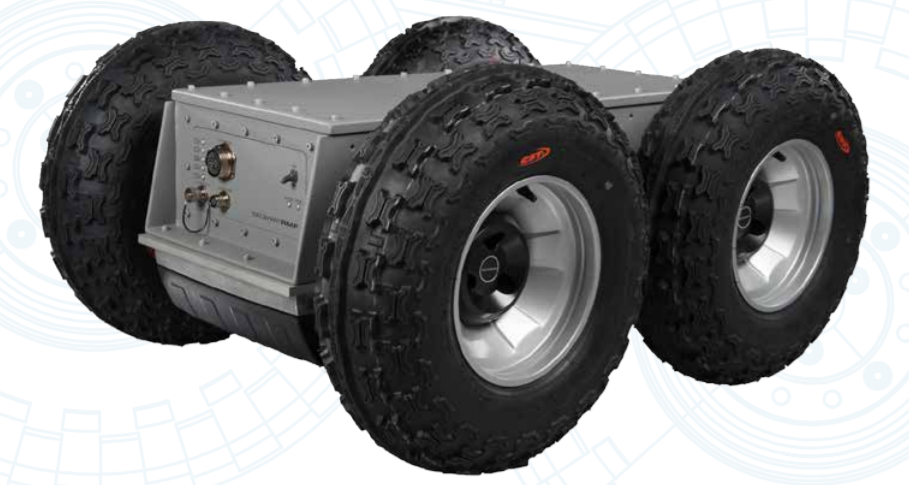 |
 |
The Segway RMP440 is in many ways effective for the goal we set for crowd control management. The robot is powerful, can drive fast, though rough terrain, lasts long, is strong, and most importantly: it is flexible. It can be mounted with waterguns, shields, guns or any other tool needed for crowdcontrol. Also, the cost is relatively low since the design does not include really advanced hardware. This relatively low cost is important: When multiple robots are purchased and then set up to connect to each other, these things could be driven by an autonoum program that navigates multiple of these robots simultaniously, performing known crowd control techniques for optimal crowd control. Since the control software is already written, it would only have to be modified and adapted for autonomous control.
Endeavor Robotics Kobra
The Kobra from Endeavor Robotics is like the Segway RMP440 an off-road flexible transportation robot. From their specification sheet:
The Kobra was designed to provide unmatched strength, power and payload support in an easy to operate robot package. Kobra has a lift capacity of 330 pounds (150 kg) and integrates numerous payloads to expand your operational area. Kobra can reach over 11.5’ feet (3.5 m), easily climb stairs, fit through doorways or down aisle-ways and store or deploy directly from the back of a small 4x4 vehicle. Able to achieve sustained speeds of 8 mph (12.9 km/h) while carrying 150-pound payloads, the Kobra maintains mobility on rough terrain in all weather conditions.
It can climb 55 degrees slopes, even steeper than the Segway RMP440. It also comes with four cameras, radio repeater compatible with the Endeavor Robotics software, and can be expanded with multiple accessories, sensors and disruptors (guns). Also it's runtime is 10 hours at operating conditions.
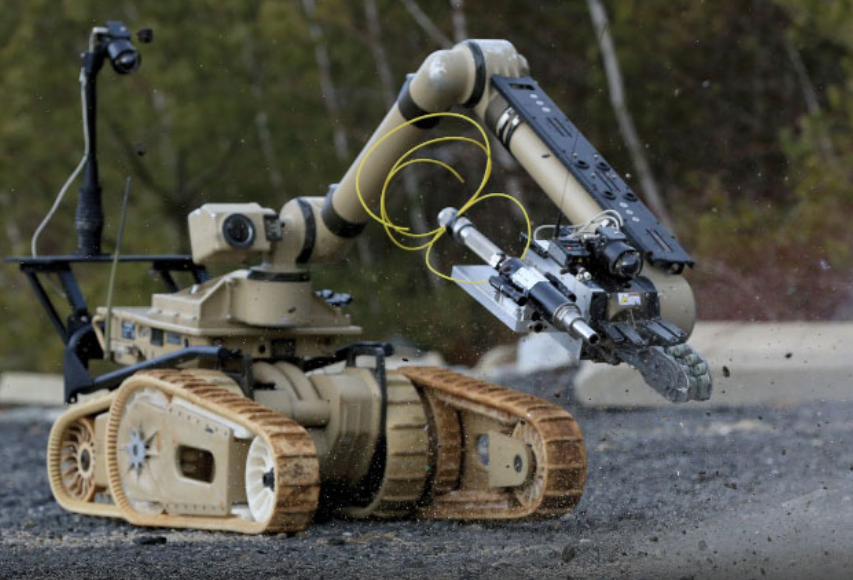 |
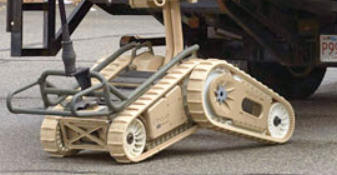 |
What makes this robot especially viable for our goal is the special caterpillar capability illustrated in the figure on the right. The robot has four caterpillars which can move independently. This results in optimal grip on all terrains, can deal with sudden changes in elevation (such as sidewalk curbs). It also enables for flexible movement and zero radius turns.
Evolutionary Artificial Potential Field
This method of robot control focusses on single robot control, but is probably a good option to expand for multiple robot control. The Evolutionary Artificial Potential Field (EAPF) method in general deal with motion planning that includes two different but complementary tasks: plath planning and motion planning. Path planning is responsible for generating a set of positions in the workspace that can drive the robot from it's initial position to the target position. Motion planning takes in account the path plan, but translates this to how the robot should actuate this path.
The EAPF is actually an optimisation of the Artifical Potential Field (APF) method. The APF method is illustrated in the figure below:

The robot in this figure prefers low rather than high potential, thus moves from the right to the left meanwhile avoiding the repulsive pillars. This method seems fine, however there is a massive drawback: the robot could be trapped in a local minimum of potential and get stuck. The problem is the robot checks the potential locally, and when it has navigated to a minimum it has no way of knowing how to proceed since locally, the potential is worse in every direction. This is illustrated in the APF Local Minimum figure.
It also turns out the system has difficulties in dynamic situations where obstacles change position or suddenly appear.
To solve the minimum problem of APF, EAPF was designed. EAPF attaches a cost to the potential. The EAPF method then tries to find a path to the goal that minimizes this cost. Only information on the position of the robot, obstacles and the goal is needed for this method. This way, a global planning is implemented to solve the local planning issue of local minima.
In the paper Optimal Path Planning Generation for Mobile Robots using Parallel Evolutionary Artificial Potential Field cited in the sources chapter, an even better method is proposed which uses the EAPF and adds Generic Algorithms to improve the path planning for dynamic environments with less computational power and a bigger workspace. Experiments in the paper show some promosing results shown in the figures below. The most important thing is that it can handle a dynamic environment, since the crowd control robots will experience this; there is no predefined map of the situation.
 |
 |
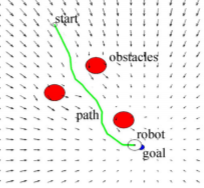 |
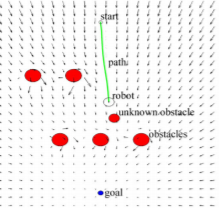 |
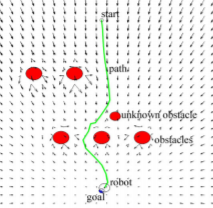 |
Crowd control technique
In the US Army Field Manual, different crowds are described on which to use different tactics. The Manual describes 3 crowd types: Public disorder, Public disturbance and Riot. With Public disorder being non-violent crowds, Public disturbance is where crowds start chanting and singing collective opinions. Some individuals will disturb the normal flow of things. A riot is the most extreme type of crowd, where crowds turn violent and actively try to defeat authorities and the controlling force.
For the control of a crowd, it is important to know it's type so control forces can react accordingly. To identify it's type, background information is needed. An assesment can be made by asking questions:
- Who are they? What is the identity of the crowd? Are they strikers, ethnic factions or social protesters?
- What are their goals?
- What are they capable of doing?
- What are their traditional behaviors?
- When and where will they assemble?
- Where will they go?
- What are the possible targets of violence?
- What is the worst case scenario?
- When and where will they disperse?
Knowing these questions is essential to decide on the tactic to control the crowd with. Too offensive can react to unnecessary violence, whereas too soft can react to an out of control situation.
For a public disorder, often it is enough to stand by and watch for disturbance. Public disturbance and riot often needs more advanced tactics. First of all, when a riot is started, it is important to deter people from joining or leaving the riot. This by for example extensive patrolling, or proclamate the illigality of the riot. Alert, agressive patrolling of the disturbance area deters the gathering of crowds, it also allows for information to be collected, and it creates the psychological impression of the control force being everywhere at once. The use of vehicles provide adds to that effect: The control force is better equipped than the crowd. Varying patrol routes and times keep lawbreakers from being able to pick a safe place or time to act. Proclamating the illigality of the riot makes people aware of the individual and how he is acting illigal. In a crowd, a feeling of shared responsibility causes people to behave different compared to when people are aware of the responsibility they themselves have. Making people aware of themselves and the illigalities they do by proclamation can stop this shared responsibility and deter people. Also warnings can be verbally proclamated like warnings of lootings: "During a disturbance, criminal activity is at it's peak. Your house may be getting looted now, return to your homes!" However, to really try to control the crowd, forces have to either disperse, or contain the crowd.
Containment is the process of limiting a crowd to the area they are presently occupying. It is a suitable option when the crowd must be prevented from spreading to surrounding areas and communities. Perimeter patrols and barriers have to be set up to contain the crowd. However, containment has to be acted upon with caution, to avoid the "fight or flight" syndrome common to people feeling trapped with no escape. Containment contains a lot of coördination. Barriers have to be set up at specified locations. Vehicles or forces have to be traveling at close interval in formation. Dispersion is the process of taking deliberate actions to fragment an assembled crowd in order to prevent the destruction of property or prevent injury. Dispersion is done by proclamations, show of force and moving in crowd control formations. The difficulty of dispersion is channeling the dispersion route. The dispersed crowd should preferably take a chosen route where the crowd can safely and calmly leave the area. Dispersing crowds into wide-open areas for example is unwanted since a new gathering can occur. The crowd should be kept moving, but not too hurried to avoid panic.
This projects opts for Civil Disturbance Formations executed partly by robots. Especially the front of each formation should be operated by robots to minimise damage to the control force. There are different formations (A,B,C, are the squad members, other signs are leaders etc. in the figures below):
- Line formation is the most used formation because it's offensive and defensive applications. As offensive, the line is used to push or drive crowds straight back across an open area or street. Defensive to hold the crowd or deny acces to a certain area.
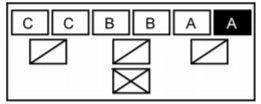
- Echelon formation is an offensive formation to drive crowds away from buldings, fences and walls.

- Wedge formation is an offensive formation to penetrate and split crowds into smaller groups.
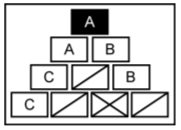
- Diamond formation is a defensive formation that offers all-around security when in an open area.
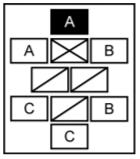
Ideally, the robot designed for this project would be able to execute these formations. The robots should be communicating with eachother sharing location and sensor information to execute this.
Police thoughts
User thoughts
Design
Requirements
To design this kind of robot there are three sorts of requirements that have to be met. First of all the robot needs to meet some technical requirements, it must have the tools to accomplish something. Then there are two sorts of functional requirements, first there are the requirements about the decision making of the robot. Second there are ethical requirements, while there are a lot of ethical rules when you treat with people.
Decision making: During a riot, people must be driven to a safer place, the robot has to make a decision when to push the people and to what place. Therefore the robot need to have contact with the other robots and riot police, together they have to make a choice what the best option is. The robot also need to make decisions when it comes to signaling crimes, so they can arrest them.
Technical requirements: The robot has to sustain a lot of violent people, so it needs to be made out of sustainable, hard materials. Next to that it has to stand solid as people will try to push it over, it must hold over 10 people pushing against the robot. Furthermore it must have the ability to arrest people, so it has to have a mechanism to hold people. For making the decisions the robot must see, it has to have an overview of the situation, it must detect people, actions and safer places.
Ethical requirements: Because you are dealing with people there are a lot of ethical rulings you have to take in mind. You can't assault a troublemaker without any reason, also the means are restricted by these ethics. Shooting is easily ethical irresponsible, you also can't hold a person without reason. These ethical decisions will have to be implemented in the decision making, in a further stage of the project we will discuss the ethical restrictions and possibilities.
Functional
Technical
Validity of design
Police thoughs
User tests
prototype?
Sources
Endeavor Robotics Kobra http://endeavorrobotics.com/products#710-kobra Endeavor Robotics Kobra Spec Sheet http://endeavorrobotics.com/media/docs/English%20Specs/Endeavor%20Robotics%20PackBot%20Spec%20Sheet.pdf Segway RMP440 Spec Sheet http://rmp.segway.com/downloads/RMP440LE.pdf PEAPF Navigation technique https://link-springer-com.dianus.libr.tue.nl/content/pdf/10.1007%2Fs10846-014-0124-8.pdf Crowd Control Technique https://fas.org/irp/doddir/army/fm3-19-15.pdf Gustave Le Bon, The mind of Crowds http://www.gutenberg.org/files/445/445.txt Freud Group Psychology http://freudians.org/wp-content/uploads/2014/09/Freud_Group_Psychology.pdf Social identity theory and other social theories https://www.simplypsychology.org/social-identity-theory.html Irrational riots http://news.ku.dk/all_news/2013/2013.4/riots_create_irrational_behaviour/
1. catagorizeren papers
2. Lezen
3. Probleemstelling opstellen: Waarom is onze robot nodig?
4. Definiëren wat we gaan inleveren/deliveren.
Papers and articles:
- Human Robot Interaction
- (1) Humanoid robots state of the art, and human reaction (book) https://link.springer.com/content/pdf/10.1007%2F978-0-387-85349-9.pdf
- Psychology of Rioting
- (2) Crowd action as intergroup process: Introducting the police perspective http://onlinelibrary.wiley.com.dianus.libr.tue.nl/doi/10.1002/(SICI)1099-0992(199807/08)28:4%3C509::AID-EJSP877%3E3.0.CO;2-C/abstract
- (3) Cops and Chaos: A Historical Examination of the Police Role in Riot Control http://www.tandfonline.com/doi/full/10.1080/19361610.2015.1069532?scroll=top&needAccess=true
- (4) Crowd theory and the management of crowds: A controversial relationship http://journals.sagepub.com/doi/10.1177/0011392113486443
- (5) Contemporary understanding of riots: Classical crowd psychology, ideology and the social identity approach http://journals.sagepub.com/doi/10.1177/0963662516639872
- Conflict escalation
- Riot Simulation
- (6) Analysis of a riot in Burnley http://www.tandfonline.com/doi/abs/10.1080/10439460410001674956
- Crowd Management
- (7) Interactive Control of Large-Crowd Navigation in Virtual Environments Using Vector Fields http://ieeexplore.ieee.org/abstract/document/4670099/
- Robot utility in riots
Citations and information from articles
Crowd action as intergroup process: Introducting the police perspective
Treating the crowd as an homogeneous whole plays an important role in escalating
Conflict occurs where crowds gather because it is in the very nature of crowds to be conflictual
The police officers see the crowd as an heterogeneous whole
Some of those, I am sure, the vast majority were good law abiding people under normal circumstances. But when you are in a group like that, I am sure that, the fever of the cause, the fever of the day, the throwing and everything else, they get locked together and think ``oh we are part of this. – Chief inspector during the poll tax riots
Only one black sheep in the herd, with law abiding people, can stir the whole crowd up
However heterogeneous crowd composition might be, once people get together in the crowd homogenizing processes take over. Everybody is potentially violent and, once violence actually starts, everybody is liable to join in.
When trouble occurs and the police intervene, their tactics are generally aimed at getting rid of the threat entirely: dispersing the crowd, driving it in a particular direction, dividing it and containing it
Pc 8: `You haven't got the discussion time'. Pc 10: `No, you are talking about a split second decision'. Pc 8: `your main aim in that situation is not to make arrests but to clear the streets and stop a public order situation. You are running through, you have got to make very quick assessments of people. It is just a quick and difficult assessment and you will make wrong assessments' (Grp. 2, BTb).
When going in without violence you wouldn’t come out alive.
Cops and Chaos: a historical examination of the police role in riot control
The first thing law enforcement officials can do to control collective violence is to be professional in their daily dealings with the people they serve. History has shown that people everywhere demand to be treated fairly.
While it is clear that the police are not singlehandedly responsible for the enormity of slavery, segregation, and discrimination, the police are representatives of the government and society at large.
As noted by the U.S. Department of the Army (2014, pp. 2–6), winning in a crowd control mission “is not like winning in combat. (...) Winning in this environment is about seizing and holding the moral high ground.”
For starters, rather than wearing riot gear, officers should wear standard uniforms or perhaps even, depending upon the weather, casual uniforms such as knit shirts and short pants. Having officers prepare for a protest by means of donning riot gear complete with helmets, shields, and batons at the ready may psychologically prep the officers and the crowd for conflict (Madensen & Eck, 2006; Masterson, 2012). In contrast, having officers meet, greet, shake hands, and make small talk with crowd members can help forge “a psychological bonding with the crowd that pays real dividends. It is very difficult to fight the police if you’ve just been friendly with some individual officers”
This does not mean that, at the first sign of trouble, police officers in riot gear need to form a phalanx with their shields locked and batons drawn and advance toward the crowd. Research suggests that such synchronized actions nourish aggression.
A critical analysis of the Burnley riot
Through being undermanned, the white youth became only more confident about, so the situation began to escalate.
First, the police were present in insufficient numbers given the likely magnitude of the brewing confrontation; and second, the key decision to withdraw officers from a scene of growing white racist hostility outside the Baltic Fleet signalled to the Asian communities that, since the police were apparently unwilling or ill-prepared to defend them, they would have to take their safety into their own hands.
Team progress
28-9-2017: Through reading of the articles a clear problem description was defined in a discussion and will be elaborated by Bern. Furthermore the deliverable is chosen:
- RPC's
- Case study
- Design
The wishes for the RPC and design will be elaborated by Sjoerd and the case study by Luke.